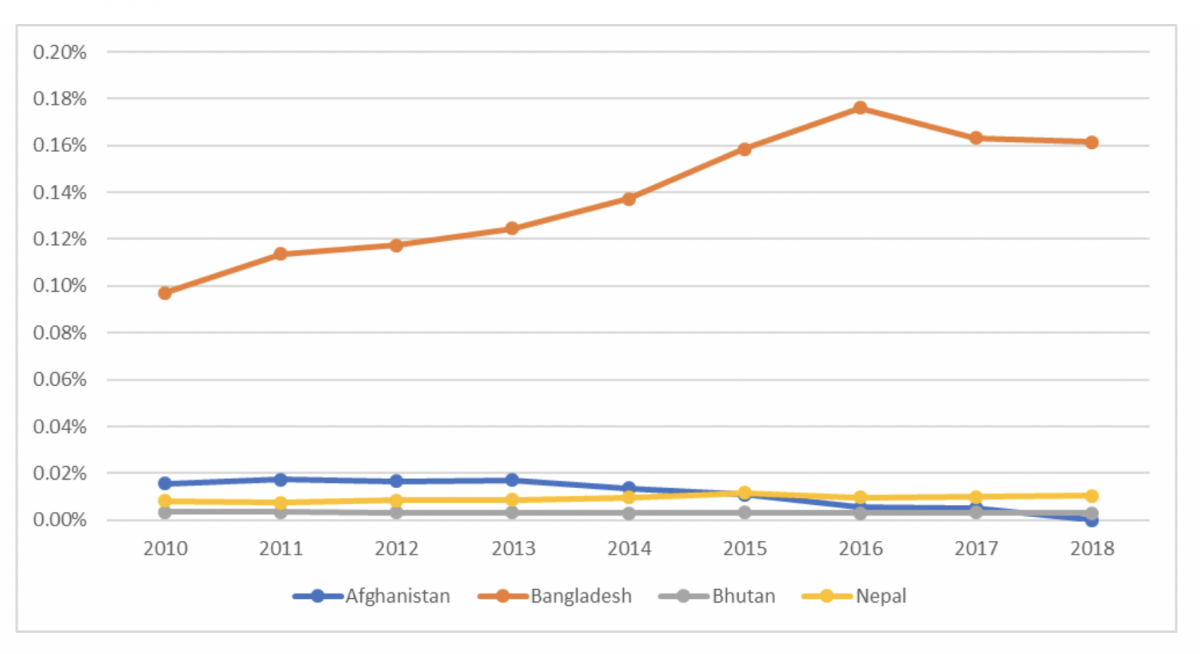How will graduation impact countries in South Asia and the trade support they benefit from? How can they prepare?
Least developed countries (LDCs) are classified as such by the United Nations (UN), designated by their low levels of income and structural impediments to growth. For these countries, international support measures (ISMs) are provided in the areas of trade, development cooperation and assistance with participation in the UN and other international processes.
Trade-related ISMs for LDCs include preferential market access for trade in goods and services, and special treatment by the World Trade Organisation (WTO) and with regional and bilateral trade agreements. Once a country graduates from LDC status, they can no longer benefit from ISMs.
The loss of preferential market access upon LDC graduation will impact countries differently, depending on their utilisation of preference schemes and their productive capacity, export structure and markets. In South Asia, three of the four LDCs, namely Bangladesh, Bhutan and Nepal, are in the process of graduating. They have mostly benefitted from preferential market access like the European Union's Everything But Arms (EBA) initiative, Duty-Free Quota-Free (DFQF) access, preferential rules of origin (ROO) and some bilateral and regional trade agreements. Upon graduation, DFQF access and preferential ROO will no longer be available; the EBA continues for up to three years.
Bangladesh will face the biggest challenge given their main export of clothing under LDC preferential market access to the EU, Canada and Japan, as well as the pharmaceutical sector benefitting from trade-related intellectual property flexibility for LDCs. Bhutan will be least affected due to its bilateral Free Trade Agreement (FTA) with India under which fall more than 80% of its exports, in addition to the supply of electricity to India. None of these will be adversely affected by graduation.
The drop in tourism due to COVID-19 is impacting Bhutan and Nepal. Nepal received only 34,025 foreign tourists in March 2020, a sharp drop from 101,400 in February and 79,686 in January 2020.
Nepal to some extent will be negatively impacted, but to a lesser degree than Bangladesh. Around 60% of Nepal’s global exports are to India, covered under the bilateral FTA, and the remaining exports are to the United States, the EU and China, most of which are under DFQF access. Upon graduation, while Nepal will continue to get preferential access to the Indian market, its exports of textiles and clothing to the EU and other markets will be negatively affected due to the loss of DFQF access.
Market access challenges
The loss of preferential market access means graduating countries need to increase their export competitiveness and diversify their export markets and products. Yet, South Asian LDCs, like many others, face several challenges. These include low productivity, export concentration both in terms of markets and products, lack of technology and the need for structural transformation.
Over the years, the economic structures of the South Asian LDCs Afghanistan, Bangladesh, Bhutan and Nepal have not undergone many changes. This is hampering their capacity to trade, and is shown in the stagnancy of their share in global exports (see Figure 1). Only Bangladesh saw an increase – of 66.4%, from 0.1% in 2010 to 0.16% in 2018. Nepal had an increase of 28.2%, from 0.008% in 2010 to 0.1% in 2018. Afghanistan and Bhutan saw a decline of 66.5% and 15% respectively during the period. Given the spread of COVID-19 affecting many of their export markets, signs of market slowdown are already being seen, and thus these LDCs will see a decline in their export share in the coming months.
Figure 1: South Asian LDCS: Export share of global exports (goods and services)

Source: Calculation based on data from World Development Indicators, World Bank
Facing a pandemic
The international trade situation is grimmer now due to COVID-19. World merchandise trade is estimated to decline by 13-32% in 2020, with many of the LDCs’ major markets seeing a contraction in import demands. And, global GDP is slipping by 3%, equivalent to US$9 trillion. LDC exports in 2020 and in the following years will further deteriorate, which will bring much greater challenges for graduation.
COVID-19 has impacted not only the demand side of the market but also the supply side, and due to several restrictions on cross-border transportation, has disrupted supply chains. For example, Bhutan and Nepal are highly dependent on their exports to India, which has reported its imports in March 2020 were US$31.16 billion, a decline of 28.72% over imports in March 2019. This is due to border restrictions and restrictions on transport of non-essential items that were imposed by the Government of India due to coronavirus. Any decline in Indian imports will seriously affect the exports and thus overall economies of Bhutan and Nepal.
The drop in tourism due to COVID-19 is impacting Bhutan and Nepal. Nepal received only 34,025 foreign tourists in March 2020, a sharp drop from 101,400 in February and 79,686 in January 2020. Bhutan suspended all tourist visas from 6 March onwards until further notice. In Bangladesh, it has been estimated that export orders worth US$3 billion were either cancelled or suspended by global garment retailers and brands due to COVID.
Transitioning
In working toward graduation, the LDCs in South Asia will have to implement policy reforms that support their economic diversification and resilience, and that reduce their trade costs, otherwise their path to sustainable graduation will be very rocky. For Bangladesh and Nepal, it will be important to engage with preference-granting countries to see how they can still use preferential market access and explore new trade agreements. The Generalised System of Preferences (GSP) will be available to them, but they need to evaluate the pros and cons if they can use the EU GSP+ scheme, which gives better tariff preferences than GSP. They will also have to see how best they can use these systems and other regional markets to promote exports of other sectors with potential, for example, fish and crustacean in the case of Bangladesh; and tea, medicinal and aromatic plants, and cardamom in the case of Nepal.
It is also critical for graduating LDCs in South Asia to look into leveraging technologies and FDI to improve the competitiveness of their key exports, create brands and move up the value chain. Political will to force structural transformation is another prerequisite for export diversification, thus ensuring a sustainable path to graduation.
Finally, it is also important that development partners, especially international organisations like the UN and WTO, make a concerted effort to support LDCs in South Asia to formulate policies during the transition period so that the challenges of graduation can be addressed.
-----------------------
The views expressed are personal and should not be attributed to EIF, the United Nations or its member States. This article draws upon UNESCAP-SSWA (2020) Towards Sustainable Graduation of South Asian LDCs in the aftermath of COVID-19 (forthcoming).
The authors are thankful to Nagesh Kumar, Director, UNESCAP, New Delhi, and Ratnakar Adhikari, Executive Director, EIF, for their valuable inputs.
Header image of a hospital testing for COVID-19 in Madagascar - ©World Bank/Henitsoa Rafalia via Flickr Creative Commons Attribution-NonCommercial-NoDerivs 2.0 Generic (CC BY-NC-ND 2.0) license.
If you would like to reuse any material published here, please let us know by sending an email to EIF Communications: eifcommunications@wto.org.



